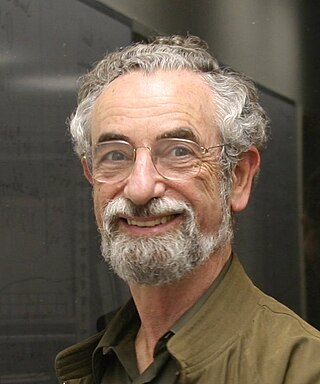
In condensed matter physics, a spin glass is a magnetic state characterized by randomness, besides cooperative behavior in freezing of spins at a temperature called "freezing temperature" Tf. In ferromagnetic solids, component atoms' magnetic spins all align in the same direction. Spin glass when contrasted with a ferromagnet is defined as "disordered" magnetic state in which spins are aligned randomly or without a regular pattern and the couplings too are random.

Mathematical physics refers to the development of mathematical methods for application to problems in physics. The Journal of Mathematical Physics defines the field as "the application of mathematics to problems in physics and the development of mathematical methods suitable for such applications and for the formulation of physical theories". An alternative definition would also include those mathematics that are inspired by physics, known as physical mathematics.
In mathematics, an ultrametric space is a metric space in which the triangle inequality is strengthened to for all , , and . Sometimes the associated metric is also called a non-Archimedean metric or super-metric.

In mathematics, the representation theory of the Poincaré group is an example of the representation theory of a Lie group that is neither a compact group nor a semisimple group. It is fundamental in theoretical physics.

Elliott Hershel Lieb is an American mathematical physicist. He is a professor of mathematics and physics at Princeton University. Lieb's works pertain to quantum and classical many-body problem, atomic structure, the stability of matter, functional inequalities, the theory of magnetism, and the Hubbard model.
In the statistical physics of spin glasses and other systems with quenched disorder, the replica trick is a mathematical technique based on the application of the formula:
The cavity method is a mathematical method presented by Marc Mézard, Giorgio Parisi and Miguel Angel Virasoro in 1987 to derive and solve some mean field-type models in statistical physics, specially adapted to disordered systems. The method has been used to compute properties of ground states in many condensed matter and optimization problems.

Arthur Michael Jaffe is an American mathematical physicist at Harvard University, where in 1985 he succeeded George Mackey as the Landon T. Clay Professor of Mathematics and Theoretical Science.

Giorgio Parisi is an Italian theoretical physicist, whose research has focused on quantum field theory, statistical mechanics and complex systems. His best known contributions are the QCD evolution equations for parton densities, obtained with Guido Altarelli, known as the Altarelli–Parisi or DGLAP equations, the exact solution of the Sherrington–Kirkpatrick model of spin glasses, the Kardar–Parisi–Zhang equation describing dynamic scaling of growing interfaces, and the study of whirling flocks of birds. He was awarded the 2021 Nobel Prize in Physics jointly with Klaus Hasselmann and Syukuro Manabe for groundbreaking contributions to theory of complex systems, in particular "for the discovery of the interplay of disorder and fluctuations in physical systems from atomic to planetary scales".
Miguel Ángel Virasoro was an Argentine mathematician and theoretical physicist. Virasoro worked in Argentina, Israel, the United States, and France, but he spent most of his professional career in Italy at La Sapienza University of Rome. He shared a name with his father, the philosopher Miguel Ángel Virasoro. He was known for his foundational work in string theory, the study of spin glasses, and his research in other areas of mathematical and statistical physics. The Virasoro–Shapiro amplitude, the Virasoro algebra, the super Virasoro algebra, the Virasoro vertex operator algebra, the Virasoro group, the Virasoro conjecture, the Virasoro conformal block, and the Virasoro minimal model are all named after him.

Michel Pierre Talagrand is a French mathematician. Doctor of Science since 1977, he has been, since 1985, Directeur de Recherches at CNRS and a member of the Functional Analysis Team of the Institut de Mathématique of Paris. Talagrand was also a faculty member at The Ohio State University for more than fifteen years. Talagrand was elected as correspondent of the Académie des sciences of Paris in March 1997, and then as a full member in November 2004, in the Mathematics section. In 2024, Talagrand received the Abel Prize.
Bálint Tόth is a Hungarian mathematician whose work concerns probability theory, stochastic process and probabilistic aspects of mathematical physics. He obtained PhD in 1988 from the Hungarian Academy of Sciences, worked as senior researcher at the Institute of Mathematics of the HAS and as professor of mathematics at TU Budapest. He holds the Chair of Probability at the University of Bristol and is a research professor at the Alfréd Rényi Institute of Mathematics, Budapest.

Jürg Martin Fröhlich is a Swiss mathematician and theoretical physicist. He is best known for introducing rigorous techniques for the analysis of statistical mechanics models, in particular continuous symmetry breaking, and for pioneering the study of topological phases of matter using low-energy effective field theories.

Huzihiro Araki was a Japanese mathematical physicist and mathematician who worked on the foundations of quantum field theory, on quantum statistical mechanics, and on the theory of operator algebras.

Tetsuji Miwa is a Japanese mathematician, specializing in mathematical physics.

Roberto Longo is an Italian mathematician, specializing in operator algebras and quantum field theory.

Erwin Bolthausen is a Swiss mathematician, specializing in probability theory, statistics, and stochastic models in mathematical physics.

Fabio Toninelli is an Italian mathematician who works in probability theory, stochastic processes and probabilistic aspects of mathematical physics.

Jan Philip Solovej is a Danish mathematician and mathematical physicist working on the mathematical theory of quantum mechanics. He is a professor at University of Copenhagen.














